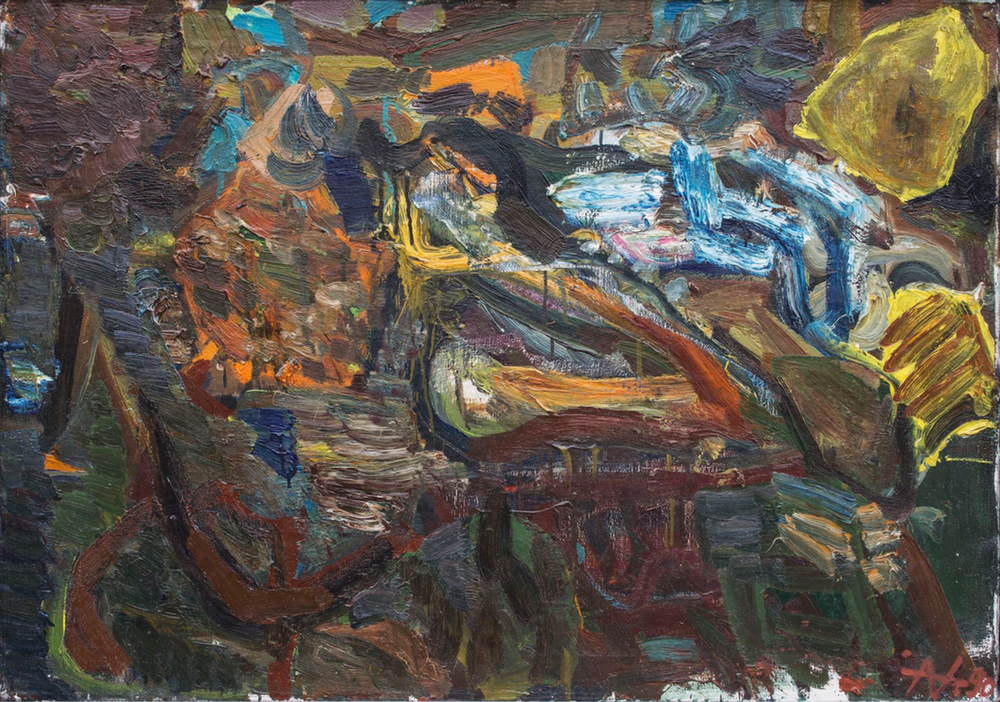Arūnas Vaitkūnas ir Aušra Barzdukaitė-Vaitkūnienė
After returning from his studies to Kaunas in 1980s, Arūnas Vaitkūnas chose one motif that fascinated him, the atmosphere of an old staircase, and researched it for a while in his paintings as his own identity. Travelling through the world of staircases he, probably more than anybody else, encountered unusual perspectives, intertwined handrails, expressive lines of cross-beams, mysterious play of heights.
His study, where the artist produced his most famous pieces, still remains in the attic of the house in Daukšos street. Tilting our head back to the roofs of the buildings we can only dream of what else the painter might have created through his constant experimentation with colour, composition and overall structure of the painting, having not turned his back to the new arts manifesto, left to us by the Ars painters.
One can feel an observant and consistent painter creating a Renaissance model and not a wild primitivism or automation in the work of Arūnas Vaitkūnas, even in abstractions devoid of objects, obscure forms, shapes and scattered spots.
Fascinated with old masters and able to apply their painting in his own work, he seemingly could effortlessly and masterfully turn over the history of painting, like pages in a book. Sometimes very different, but easily recognisable historical details, reminiscences of rembrandtesque chiasoscuro or colouristic contracts, preferred by expressionists back in the day, would merge in such painting. Fast discovery, instant comprehension and expression with exceptional colours and strokes were so customary and unbelievable in the works of Arūnas Vaitkūnas that it will not be forgotten any time soon.
Nowadays painter Aušra Barzdukaitė-Vaitkūnienė is working in the study on Daukšos street. She understands it does not take long for the city to reclaim any antiquity, but still knows of one place in Benediktinių street, where an old house, used as a motif for Arūnas Vaitkūnas’ staircase painting, still stands. Other houses have been renovated, just like their staircases, and today one can hardly access them, however, the painter’s canvases still retain the spirit of the interiors from a previous city.
Aušra Vaitkūnienė depicts human stories in her pieces, usually without depicting people at all. Sometimes she reconstructs a near past realistically – a walk through the city streets or her yard, occasionally adding tales of other observers to the picture.
The painter, trying new means of expression again and again, does serious research into optical and physical objects and manages to spread a veil of mysterious insight that right there, just around the corner, irrational things exist. This painting magic wreak havoc on the onlookers’ emotions, making them get lost in their own city, in a sense of place as well as time.
For example, Aušra Vaitkūnienė, having lived in Žaliakalnis since childhood, has her own places there. She’s been long attracted to a former monastery with its apple-trees in Žemaičių street (museum of education during the Soviet period). After the independence the building was returned to Franciscan sisters. And Aušra still experiences overlapping memories and a sense of déjà vu while walking past it, it helps her ponder painting and time.
Arūnas Vaitkūnas (1956-2005) was born and went to school in Kaunas. After graduating from Kaunas J. Naujalis Secondary School of Arts (today – Kaunas Art Gymnasium) went to study in Vilnius. Studied painting at the National Arts Institute in Vilnius (nowadays Vilnius Academy of Arts) from 1974 to 1980. Was a painting teacher at the Kaunas S. Žukas Technical School of Applied Fine Arts (nowadays – Kaunas University of Applied Sciences, Faculty of Arts and Education). Worked as a show exhibitor at the M. K. Čiurlionis National Museum of Art in 1983-1985. Was employed as a painting teacher at the Kaunas J. Naujalis Secondary School of Arts in 1985-1993. Member of Lithuanian Artists’ Association from 1990. From 1993 – member of artist group “Angis”. Was a lecturer at the Kaunas Fine Arts Faculty of the Vilnius Academy of Arts from 1992, associate professor from 1994, professor from 2003. Received grants from foreign art funds (Germany, Austria, USA), also an individual grant of Lithuanian State in 2001.
The works of Arūnas Vaitkūnas have been acquired by the M. K. Čiurlionis National Museum of Art, MO museum, Kaunas Modern Art Foundation, other private collectors in Lithuania and abroad.
Aušra Barzdukaitė-Vaitkūnienė was born in Kaunas in 1962. Was a student at Kaunas J. Jablonskis Secondary School in 1969-1980. Studied painting at the National Arts Institute in Vilnius (nowadays Vilnius Academy of Arts) from 1980 to 1986. Takes part in exhibition in Lithuania and abroad since 1987. Member of the artist group “Four” in 1990-2002. Member of Lithuanian Artists’ Association since 1992. Was a lecturer at the Kaunas University of Applied Sciences for a few decades since 1988, works as a lecturer at the Kaunas Fine Arts Faculty of the Vilnius Academy of Arts since 2009, head of the painting department, professor since 2021. After her husband’s passing in 2005 takes care of promoting his creative works.
The works of Aušra Barzdukaitė-Vaitkūnienė have been acquired by the Lithuanian National Museum, M. K. Čiurlionis National Museum of Art, MO museum, other private collectors in Lithuania and abroad.
Back to the map




